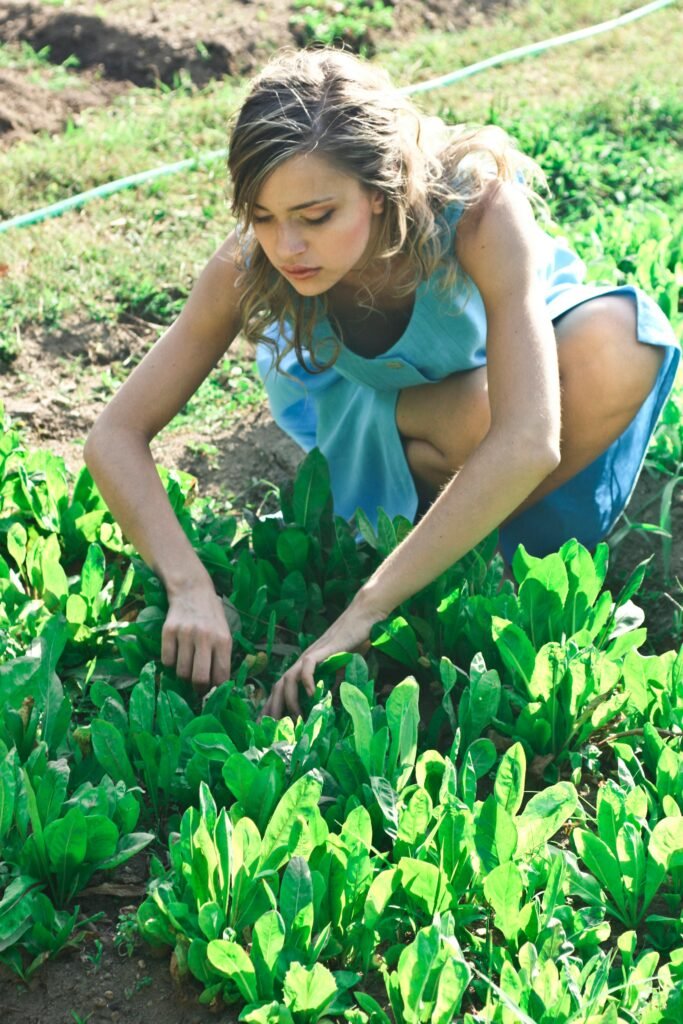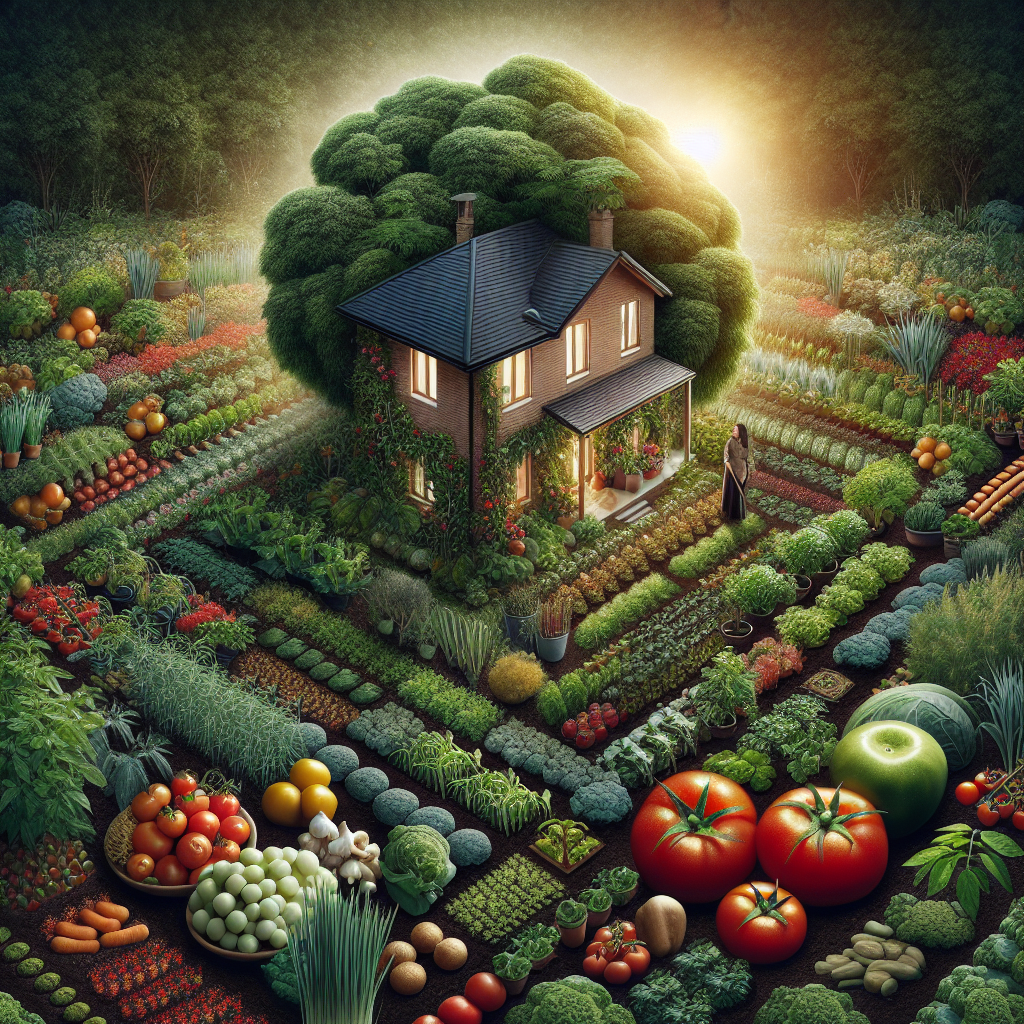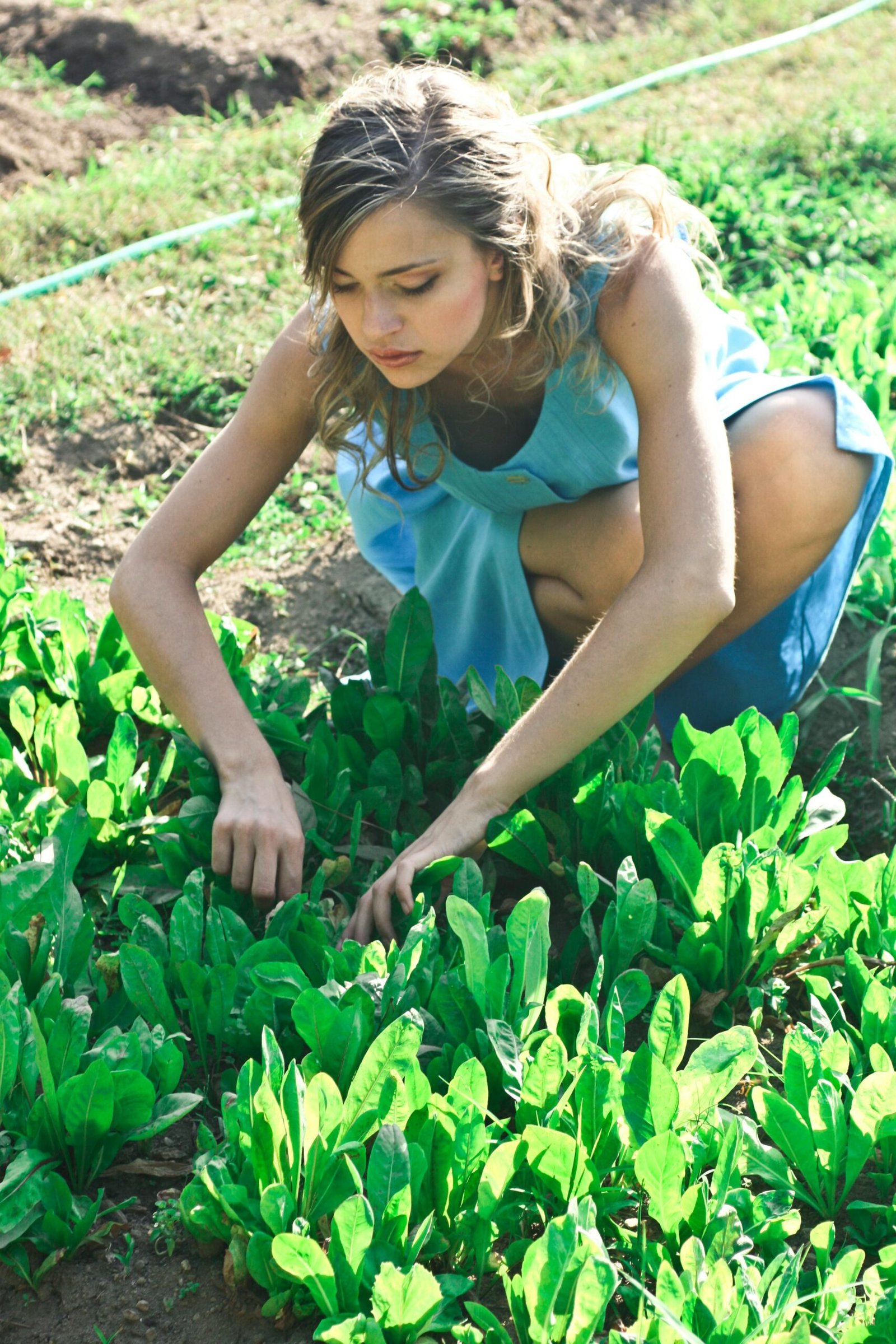Imagine having a lush and vibrant garden right in your backyard, filled with fresh fruits, vegetables, and beautiful flowers – all sustainably grown and nurtured by your own hands. With a few simple tips and tricks, you can transform your outdoor space into a sustainable home garden that not only adds beauty to your surroundings but also helps promote a healthier environment. From selecting the right plants to implementing eco-friendly practices, this article will guide you on how to create and manage a sustainable home garden that brings joy and sustainability to your everyday life.

Choosing the Right Location
Assessing sunlight and shade
When choosing a location for your sustainable home garden, it is important to assess the amount of sunlight and shade that the area receives throughout the day. Most plants require at least six hours of direct sunlight each day to thrive, so selecting a location with adequate sun exposure is crucial. Take note of any buildings, trees, or other structures that may block or shade the area during certain times of the day.
Considering soil quality
Another key factor to consider when choosing a location for your garden is the quality of the soil. Different plants have different soil requirements, so it is important to assess the soil’s pH level, nutrient content, and texture. Sandy or clay soils may need amendments to improve drainage or increase fertility. Conducting a soil test can provide valuable information about the soil’s composition and help you make informed decisions about plant selection and soil preparation.
Analyzing drainage
Along with soil quality, it is essential to analyze the drainage in the chosen location. Poor drainage can lead to waterlogged soil, which can be detrimental to plant health. Look for areas of the garden that may be prone to standing water or excessive moisture. If necessary, you can take steps to improve drainage by adding organic matter such as compost or using raised beds to ensure that excess water can drain away from the plants’ roots.
Identifying available space
Another consideration when selecting the right location for your home garden is the amount of available space. Assess the area’s potential for growth and expansion, as well as any limitations that may affect the size and layout of your garden. Consider factors such as accessibility, neighboring structures, and any existing landscaping features that may impact the available space.
Taking climate into account
When choosing the location for your sustainable home garden, it is crucial to take the climate into account. Different regions have varying temperature ranges, rainfall patterns, and seasonal changes that can significantly impact plant growth and survival. Research the climate in your area and choose plants that are well-suited to thrive in your specific climate conditions. This will ensure that your garden has the best chance of success and minimize the need for excessive watering or protection from extreme weather conditions.
Selecting the Right Plants
Researching native plant species
To create a sustainable home garden, it is important to research and choose native plant species whenever possible. Native plants are naturally adapted to the local environment, making them more resilient and requiring less maintenance. They also provide habitat and food for local wildlife, contributing to the overall biodiversity of your garden ecosystem. By selecting native plants, you can create a garden that is both sustainable and aesthetically pleasing.
Choosing plants suitable for the climate
In addition to native plants, it is crucial to choose plant species that are suitable for the specific climate conditions in your area. Different plants have varying temperature, moisture, and sun requirements. Consider factors such as frost dates, average rainfall, and temperature ranges when selecting plants for your garden. Choosing plants that are well-adapted to your climate will increase their chances of survival and reduce the need for excessive watering or protection from extreme weather conditions.
Considering plant size and growth habits
When selecting plants for your garden, it is important to consider their size and growth habits. Some plants may grow tall and wide, while others may stay compact and upright. Plan your garden layout accordingly, taking into account the space available and the desired aesthetic. Be mindful of plants that may overshadow or crowd other plants, as this can lead to poor growth and competition for resources. By choosing plants with compatible sizes and growth habits, you can create a harmonious and thriving garden.
Opting for disease-resistant varieties
To minimize the use of pesticides and ensure the long-term health of your garden, it is advisable to choose disease-resistant plant varieties. Plant diseases can be detrimental to plant growth and can quickly spread throughout the garden if left unchecked. Research different plant varieties and select those that have a reputation for being resistant to common pests and diseases in your area. This will reduce the need for chemical interventions and promote a healthier and more sustainable garden ecosystem.
Prioritizing plants that attract beneficial insects
Another crucial aspect of sustainable gardening is attracting beneficial insects to your garden. These insects, such as bees, butterflies, and ladybugs, play a vital role in pollination and natural pest control. By choosing plants that provide nectar, pollen, and shelter for these insects, you can create a thriving ecosystem that supports a variety of wildlife and ensures the health of your garden. Research plants that are known to attract beneficial insects and incorporate them into your garden design.
Preparing the Soil
Removing weeds and grass
Before planting, it is important to remove any weeds and grass from the area where your sustainable home garden will be located. Weeds and grass can compete with your plants for nutrients, water, and sunlight, reducing their overall health and productivity. Use a hoe or garden fork to loosen the soil and remove any visible weeds or grass, making sure to remove the roots to prevent regrowth.
Amending the soil with compost
Adding compost to your soil is an excellent way to improve its fertility and structure. Compost is rich in organic matter, nutrients, and beneficial microorganisms, which help create a healthy and thriving soil ecosystem. Spread a layer of compost over the garden area and mix it into the existing soil using a garden fork or tiller. This will improve the soil’s nutrient content, water retention, and drainage capabilities.
Performing a soil test
To ensure that your soil contains the necessary nutrients for optimal plant growth, perform a soil test. Soil tests provide valuable information about the pH level, nutrient deficiencies or excesses, and overall soil composition. Testing kits are readily available at garden centers or can be sent to a professional laboratory for analysis. By understanding your soil’s specific needs, you can make informed decisions about soil amendments and plant selection.
Applying organic fertilizers
In addition to compost, organic fertilizers can be used to provide specific nutrients to your soil. Organic fertilizers, such as well-rotted manure or bone meal, release nutrients slowly, providing a steady supply of nutrition to your plants. This reduces the risk of nutrient runoff and minimizes the need for synthetic fertilizers. Follow the instructions on the fertilizer packaging and apply it evenly over the garden area, making sure to water it in thoroughly to activate the nutrients.
Ensuring proper soil drainage
Proper soil drainage is crucial for plant health and preventing waterlogged soil. If the chosen garden location has poor drainage, consider using raised beds or improving the soil’s drainage capabilities. Adding organic matter, such as compost or well-rotted manure, can help improve soil structure and drainage. Additionally, avoiding overwatering and ensuring that the soil is well-aerated can help prevent water accumulation and root rot.
Implementing Water Conservation Techniques
Installing a drip irrigation system
Water conservation is a vital aspect of sustainable gardening. Installing a drip irrigation system is an efficient way to water your plants while minimizing water waste. Drip irrigation delivers water directly to the plant roots, reducing evaporation and runoff. This method ensures that plants receive the necessary moisture while using less water overall. Consider installing a timer to control the irrigation schedule and adjust it based on the plants’ water requirements and weather conditions.
Collecting rainwater
Another effective water conservation technique is collecting rainwater. Set up a rain barrel or rainwater collection system to capture rainfall from your roof or other structures. This collected water can then be used to irrigate your garden during dry periods, reducing the need to rely solely on municipal water sources. Rainwater is free of the chemicals found in tap water and provides plants with natural nutrients, resulting in healthier and more sustainable growth.
Mulching to retain soil moisture
Mulching is an essential practice in sustainable gardening that helps retain soil moisture and suppresses weed growth. Spread a layer of organic mulch, such as straw, wood chips, or shredded leaves, around your plants. This will help prevent moisture evaporation from the soil, keeping it consistently moist and reducing the need for frequent watering. Additionally, mulch acts as a natural weed barrier, reducing the competition for water and nutrients.
Watering during the coolest part of the day
When watering your garden, it is best to do so during the coolest part of the day, typically early morning or late evening. Watering during these times reduces water loss due to evaporation and allows plants to take up water more efficiently. Avoid watering during the hottest part of the day, as the intense heat can lead to water loss and stress on the plants. By timing your watering appropriately, you can maximize water conservation and promote the overall health of your garden.
Using water-efficient gardening practices
Implementing water-efficient gardening practices can significantly reduce water consumption while maintaining a healthy garden. Consider using techniques such as grouping plants with similar water needs together, using mulch to retain soil moisture, and avoiding excessive watering. Regularly monitor the soil moisture level and adjust irrigation accordingly to prevent overwatering. These practices not only conserve water but also promote plant health and sustainability.

Encouraging Natural Pest Control
Attracting beneficial insects
Encouraging natural pest control is an essential aspect of sustainable gardening. Beneficial insects, such as ladybugs, lacewings, and parasitic wasps, are natural predators of pests and can help keep pest populations in check. To attract beneficial insects to your garden, provide them with habitat and food sources. Plant diverse flowering plants that provide nectar and pollen and avoid using chemical pesticides that can harm beneficial insects. By attracting these insects, you can reduce the need for chemical interventions and create a balanced and healthy garden ecosystem.
Utilizing companion planting
Companion planting is a technique where certain plants are grown together to benefit each other. Some plants have natural pest-repellent properties or attract beneficial insects, while others provide shade or support for climbing plants. Research companion planting combinations that work well together and incorporate them into your garden design. For example, marigolds can repel pests when planted near tomatoes, and beans can provide natural shade for lettuce or spinach.
Implementing crop rotation
Crop rotation is the practice of changing the location of crops each growing season to prevent the buildup of pests and diseases in the soil. Different plants have different nutrient requirements and attract different pests. By rotating crops, you disrupt the life cycles of pests and prevent the depletion of specific nutrients. Plan your garden layout and rotate crops accordingly, ideally following a rotation pattern of plants from different plant families.
Encouraging habitat diversity
Creating habitat diversity in your garden is essential for promoting natural pest control. Provide a range of habitats, including areas of long grass, wildflowers, and shrubs, to attract a variety of beneficial insects and other wildlife. Install birdhouses, bee hotels, and butterfly feeders to encourage pollinators and insect predators. Avoid using chemical pesticides that can harm beneficial insects and disrupt the balance of your garden ecosystem.
Using organic pest control methods
When managing pests in a sustainable home garden, it is important to prioritize organic pest control methods. Chemical pesticides can harm beneficial insects, contaminate soil and water, and contribute to the decline of pollinators. Instead, opt for organic pest control methods, such as handpicking pests, using insecticidal soaps or oils, and introducing beneficial insects. Research different organic pest control techniques and select the ones that are most effective for the pests you are dealing with. By using these methods, you can maintain a healthy garden ecosystem while minimizing harm to the environment.
Proper Planting and Maintenance
Digging proper-sized holes
When planting new seedlings or transplants, it is important to dig proper-sized holes to ensure that the plants have enough space to establish their root systems. The size of the hole will depend on the specific plant’s root size and growth habits. Dig the hole slightly larger than the plant’s root ball and deep enough to accommodate the roots without crowding or bending them. This will provide the plant with a solid foundation and room for optimal root development.
Ensuring proper spacing
Proper spacing between plants is crucial for their healthy growth and development. Each plant has specific spacing requirements based on its mature size and growth habits. Crowded plants can compete for resources, leading to poor growth and increased risk of diseases. Refer to plant tags or gardening resources to determine the recommended spacing for each plant. Ensure adequate space is allocated between plants to allow for air circulation and ease of access for maintenance tasks such as watering and harvesting.
Watering newly planted seedlings
After planting new seedlings or transplants, it is important to water them thoroughly to help them establish in their new environment. Water the plants immediately after planting, making sure the water reaches the plant’s root zone. This will help reduce transplant shock and ensure the plants have access to the moisture they need to grow. Monitor the soil moisture regularly in the following days and weeks and adjust watering as needed to ensure the plant’s needs are met.
Pruning and trimming as needed
Regular pruning and trimming of plants are essential for maintaining their health, shape, and productivity. Prune plants to remove dead, damaged, or diseased branches or foliage. This will help improve air circulation, reduce the risk of pests and diseases, and promote overall plant vigor. Trim back overgrown branches to maintain the desired size and shape of the plant and to prevent overcrowding. Use sharp and clean pruning tools to avoid damaging the plants and spreading diseases.
Removing spent flowers and dead foliage
Regularly removing spent flowers and dead foliage is important for both plant health and aesthetics. Deadheading, the removal of faded flowers, encourages plants to produce more blooms and extends the flowering period. Removing dead foliage helps prevent the spread of diseases and promotes a clean and tidy appearance in the garden. Take the time to inspect your plants regularly and promptly remove any spent flowers or dead foliage to maintain the overall health and beauty of your garden.

Managing Organic Waste
Composting kitchen scraps
Composting kitchen scraps is an excellent way to manage organic waste and create nutrient-rich compost for your garden. Save fruit and vegetable peels, coffee grounds, tea leaves, and other compostable kitchen waste in a designated compost bin or pile. Avoid adding meat, dairy, or oily foods to prevent attracting pests. Regularly turn the compost pile to promote decomposition, and within a few months, you will have valuable homemade compost that can be used to improve soil fertility and structure.
Using grass clippings and fallen leaves
Grass clippings and fallen leaves from your yard make excellent additions to your compost pile. Layer them with other compostable materials to create a balanced mix of carbon (brown material) and nitrogen (green material). Grass clippings are particularly high in nitrogen, while fallen leaves provide carbon. The combination of these two materials will help speed up the composting process and create nutrient-rich compost for your garden.
Creating a vermicomposting system
Vermicomposting, also known as worm composting, is another option for managing organic waste and producing nutrient-rich compost. Purchase a worm composting bin or create your own using a plastic container with holes for ventilation. Add food scraps and shredded paper to the bin and introduce composting worms, such as red wigglers. The worms will consume the organic matter and transform it into nutrient-rich worm castings, or vermicompost. Harvest the vermicompost and use it to enrich your garden soil or create compost tea for your plants.
Avoiding chemical pesticides
Avoiding the use of chemical pesticides is an essential aspect of sustainable gardening. Chemical pesticides can harm beneficial insects, contaminate the soil and water, and pose risks to human health. Instead, focus on creating a balanced and healthy garden ecosystem that can naturally control pests. By attracting beneficial insects, using organic pest control methods, and implementing proper cultural practices, you can minimize pest damage without relying on harmful chemicals.
Reusing appropriate plant waste
When managing your garden, consider reusing appropriate plant waste to minimize waste and support sustainability. For example, fallen leaves and dried plant material can be shredded and used as mulch or added to your compost pile. Certain invasive plants or weeds can be used as mulch in pathways to suppress weed growth. By finding creative ways to repurpose plant waste, you can reduce your impact on the environment and contribute to a more sustainable garden.
Promoting Pollination
Including pollinator-friendly plants
To promote pollination in your sustainable home garden, it is essential to include a variety of pollinator-friendly plants. Native flowering plants, particularly those with bright, fragrant, or nectar-rich flowers, are attractive to bees, butterflies, and other pollinators. Research plants that are known to attract specific pollinators and incorporate them into your garden design. By providing a diverse range of nectar and pollen sources, you can create a haven for pollinators and increase the pollination success of your plants.
Providing nesting sites for pollinators
In addition to nectar and pollen sources, providing nesting sites for pollinators is crucial for supporting their populations. Various bees and butterflies require specific nesting habitats, such as hollow stems, tunnels, or sandy areas. Create a pollinator-friendly environment by leaving some areas of your garden undisturbed, providing dead wood or nesting blocks, or creating bee hotels. These nesting sites will attract and support a diversity of pollinators, enhancing the overall ecological balance of your garden.
Avoiding pesticide use during bloom
To protect pollinators and maintain a healthy garden ecosystem, it is crucial to avoid using pesticides, especially during the bloom period. Pesticides can be highly toxic to bees, butterflies, and other beneficial insects, leading to population decline and interfering with pollination. Instead, focus on preventative measures, such as companion planting, attracting beneficial insects, and implementing organic pest control methods. By avoiding pesticide use during bloom, you provide a safe and welcoming environment for pollinators to thrive.
Creating a water source
Providing a water source in your garden can attract and support pollinators, particularly during dry periods. Create a shallow dish or use a birdbath with shallow water and place some rocks or pebbles in it to serve as perches. This will allow pollinators to land and drink safely without the risk of drowning. Maintain the water source regularly, replacing the water as needed to keep it clean and fresh. By providing a reliable water source, you can help sustain pollinator populations and promote successful pollination in your garden.
Educating about pollinator conservation
Education plays a vital role in promoting pollinator conservation and sustainable gardening practices. Share your knowledge and passion for pollinators with others, such as friends, family, and neighbors. Encourage them to create pollinator-friendly spaces in their own gardens and raise awareness about the importance of pollinator conservation. Participate in local gardening and conservation groups, attend workshops or webinars, and stay informed about current issues affecting pollinators. By spreading the word and educating others, you can contribute to the larger effort of creating a pollinator-friendly world.

Integrating Sustainable Garden Design
Incorporating native landscaping
Incorporating native plants into your garden design is a cornerstone of sustainable gardening. Native plants are naturally adapted to the local environment, requiring less water, fertilizer, and maintenance. They also provide habitat and food for local wildlife, contributing to the overall biodiversity of your garden. Research native plant species that thrive in your area and incorporate them into your garden design to create a beautiful and sustainable landscape.
Creating biodiversity by layering plants
Creating biodiversity in your garden is crucial for a healthy and sustainable ecosystem. One effective way to promote biodiversity is by layering plants of varying heights and growth habits. This mimics natural forest ecosystems and provides habitat and food sources for a diverse range of wildlife. Plant tall trees or shrubs as the top layer, followed by medium-sized plants, and finally groundcovers or low-growing plants. This layering technique promotes efficient use of vertical space, maximizes sunlight exposure, and creates an aesthetically pleasing landscape.
Designing a rain garden for water management
Designing a rain garden is an excellent way to manage water sustainably in your home garden. A rain garden is a depression in the ground that collects and absorbs rainwater runoff from roofs, driveways, or other surfaces. It allows the water to infiltrate the ground slowly, replenishing the groundwater and minimizing soil erosion. Select plants that are tolerant of both wet and dry conditions for your rain garden, creating a diverse and resilient habitat. A well-designed rain garden not only mitigates stormwater runoff but also improves water quality and supports a range of plant and animal species.
Using recycled materials
Utilizing recycled materials in your garden design helps reduce waste and supports sustainability. Consider repurposing old bricks or stones for garden paths, using reclaimed wood for raised beds or garden structures, or creating garden art from recycled materials. Using recycled materials not only reduces the demand for new resources but also adds unique character and charm to your garden. Get creative and explore various sustainable options for incorporating recycled materials into your garden design.
Implementing energy-efficient lighting
If you choose to incorporate lighting into your garden design, opt for energy-efficient options. LED lights are an excellent choice as they have lower energy consumption, longer lifespan, and produce less heat. Install solar-powered lights that utilize renewable energy sources, reducing your reliance on electricity. Place the lights strategically to highlight important features of your garden and ensure they are on timers or motion sensors to minimize energy waste. By implementing energy-efficient lighting, you can create a welcoming and sustainable garden ambiance.
Continuous Learning and Adaptation
Staying updated on gardening techniques
Gardening is a continuous learning process, and staying updated on the latest gardening techniques is essential for success. Keep yourself informed through books, gardening websites, workshops, and classes. Join local gardening groups or online communities to exchange knowledge and experiences with fellow gardeners. By staying updated on gardening practices, you can continuously improve your skills, address any challenges, and adapt your gardening approach for optimal results.
Monitoring plant health and growth
Regular monitoring of your plants’ health and growth is crucial for addressing any issues promptly and ensuring their overall well-being. Take the time to inspect your plants regularly, paying attention to signs of pests, diseases, nutrient deficiencies, or other problems. Monitor plant growth and adjust watering, fertilizing, or pruning as needed. By observing your plants closely, you can make informed decisions and take action to maintain a healthy and thriving garden.
Experimenting with different methods
Gardening provides endless opportunities for experimentation and learning. Don’t be afraid to try new methods, plant combinations, or gardening techniques. Embrace the spirit of exploration and learn from both successes and failures. Experimenting will help you discover what works best in your unique garden environment and refine your gardening practices over time. Keep a gardening journal to document your experiences, observations, and lessons learned, which can guide you in making informed decisions in the future.
Adjusting garden practices as needed
As you gain experience and knowledge, you may find the need to adjust your garden practices to better meet the needs of your plants and the changing environment. Whether it’s modifying your watering schedule, changing your plant selection, or implementing new pest control techniques, be open to adapting your gardening approach. Continuously assess and evaluate the effectiveness of your practices and make adjustments as needed. Gardening is a dynamic process, and by remaining adaptable, you can create a garden that thrives and reflects your evolving understanding of sustainable gardening.
Seeking advice from gardening communities
Gardening communities provide a wealth of knowledge, experience, and support for both novice and seasoned gardeners. Seek advice and guidance from local gardening groups, online forums, or social media communities. Share your challenges and successes, ask questions, and learn from others who have faced similar situations. Engaging with the gardening community can inspire new ideas, offer practical solutions, and foster a sense of camaraderie. Remember to respect diverse opinions and approaches, and adapt the advice you receive to suit your specific garden conditions.






